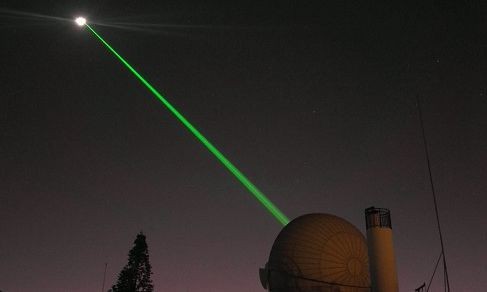In theory, a laser beam could travel up to 10 kilometers, assuming a consistent laser source. But what happens when we try to project a laser across vast astronomical distances?
Imagine pointing a laser pointer from Earth towards Mars. Could someone on the Martian surface spot it? The short answer is no, and the reason lies in the phenomenon of laser divergence over long distances.
The laser beam spreads out as it travels, reducing the brightness of the light. By the time a laser pointer’s light reaches Mars, the resulting spot’s brightness would be far below what the human eye can detect – roughly a million times dimmer than the faintest visible light.
The Power of a Laser Pointer
A standard portable laser pen (or mini laser module), typically emits light with a power of around 5mW. While this seems minimal, the concentrated nature of the laser beam focuses the energy into a very bright spot. Pointing such a laser at someone’s eyes, even from a short distance, can be 30 times brighter than looking directly at the midday sun, posing a significant danger. Never aim any laser, regardless of its power, at someone’s eyes.
 Close-up of a laser module showcasing its compact design and precision engineering
Close-up of a laser module showcasing its compact design and precision engineering
Even with their concentrated power, laser beams inevitably diverge as they propagate through the air. This divergence reduces the light source’s perceived brightness with increasing distance.
Consider a red 5mW laser. After traveling 100 meters, the beam expands to about 100 times its original size. At this distance, viewing the laser would be similar to looking at a 100-watt light bulb from approximately one meter away. Now, imagine observing the same laser from an aircraft flying at 12,000 meters. Assuming clear skies, the laser spot would appear as bright as the moon. Further away, at the International Space Station, the laser’s brightness would diminish to the level of Sirius, the brightest star in the night sky.
High-Powered Lasers: The Missile Killers
The US Navy is developing lasers powerful enough to destroy incoming missiles. To achieve this, these lasers require a power output of around 500,000 watts, a hundred million times stronger than the typical portable laser pointer. These lasers often emit infrared light, which is invisible to the human eye.
For the sake of argument, let’s imagine hypothetical Martians who can perceive infrared radiation. Military-grade lasers feature larger apertures, reducing beam divergence and enabling the laser to reach greater distances with more focused power.
If we were to aim such a missile-killing laser at the moon, the larger aperture would create an infrared light spot approximately 2.41 kilometers in diameter on the lunar surface. In contrast, a portable laser pen would produce a spot roughly 12.87 kilometers in diameter.
An observer standing on the moon within the missile-killer laser’s beam would perceive the light as being roughly 30 times brighter than the Earth. While seemingly bright, this would still only be about one-thousandth of the sun’s brightness at noon.
The Most Powerful Lasers Ever Created
Many scientific institutions house incredibly powerful lasers, some capable of emitting gigawatts of power. To achieve the same level of power with portable laser pens, you would need approximately 10 to the power of 18 individual units. Distributing these equally across the global population, each person would receive close to a billion lasers!
If operated continuously, these lasers would consume the world’s entire power supply in mere seconds.
Fortunately, these high-powered lasers release energy in extremely short bursts – often less than a trillionth of a second. This focused, ultra-short laser pulse is concentrated onto a tiny point, around a thousandth of a millimeter, achieving a light intensity ten trillion times brighter than the sun’s surface. Scientists utilize these high-energy lasers to investigate fundamental laws of the universe and even explore the very fabric of space.
Responsible Laser Use: Protecting the Atmosphere
While pointing lasers into space might seem like harmless fun, excessively strong lasers can stimulate ultraviolet (UV) light production. The Earth’s atmosphere absorbs UV light, which can increase the atmospheric burden. A better solution for deep-space exploration would be to construct a house-sized super laser gun in space.
Even in the near future, humanity might be able to launch such powerful lasers towards Mars. This would create a light spot 241.40 kilometers in diameter on the Martian surface, emitting UV rays a thousand times stronger than those experienced at noon on Earth. In such a scenario, we can only hope that Martians possess SPF-1000 sunscreen.
ELITE provides laser modules with customizable specifications, catering to diverse applications requiring accurate laser positioning and alignment. Contact them at [email protected] or 86-29-68590616 for more information.
In conclusion, while lasers can travel great distances, their visibility and potential impact depend heavily on their power, beam divergence, and the presence of an atmosphere. Responsible and informed laser use is crucial for both safety and scientific exploration.
